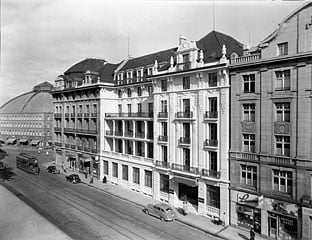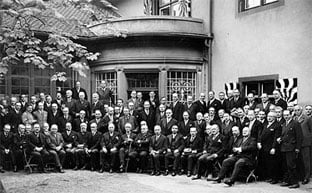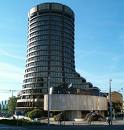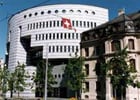In an April 7 article in The London Telegraph titled “The G20 Moves the World a Step Closer to a Global Currency”, Ambrose Evans-Pritchard wrote:
“A single clause in Point 19 of the communiqué issued by the G20 leaders amounts to revolution in the global financial order.
“‘We
have agreed to support a general SDR allocation which will inject
$250bn (£170bn) into the world economy and increase global liquidity,’
it said. SDRs are Special Drawing Rights, a synthetic paper currency
issued by the International Monetary Fund that has lain dormant for half
a century.
“In
effect, the G20 leaders have activated the IMF’s power to create money
and begin global ‘quantitative easing’. In doing so, they are putting a
de facto world currency into play. It is outside the control of any
sovereign body. Conspiracy theorists will love it.”
Indeed they will. The
article is subtitled, “The world is a step closer to a global currency,
backed by a global central bank, running monetary policy for all
humanity.” Which naturally
raises the question, who or what will serve as this global central bank,
cloaked with the power to issue the global currency and police monetary
policy for all humanity? When
the world’s central bankers met in Washington last September, they
discussed what body might be in a position to serve in that awesome and
fearful role. A former governor of the Bank of England stated:
“The
answer might already be staring us in the face, in the form of the Bank
for International Settlements (BIS). . . . The IMF tends to couch its
warnings about economic problems in very diplomatic language, but the
BIS is more independent and much better placed to deal with this if it
is given the power to do so.”1
And
if the vision of a global currency outside government control does not
set off conspiracy theorists, putting the BIS in charge of it surely
will. The BIS has been scandal-ridden ever since it was branded with pro-Nazi leanings in the 1930s. Founded
in Basel, Switzerland, in 1930, the BIS has been called “the most
exclusive, secretive, and powerful supranational club in the world.” Charles Higham wrote in his book Trading with the Enemy
that by the late 1930s, the BIS had assumed an openly pro-Nazi bias, a
theme that was expanded on in a BBC Timewatch film titled “Banking with
Hitler” broadcast in 1998.2 In
1944, the American government backed a resolution at the Bretton-Woods
Conference calling for the liquidation of the BIS, following Czech
accusations that it was laundering gold stolen by the Nazis from
occupied Europe; but the central bankers succeeded in quietly snuffing
out the American resolution.3

Modest beginnings, BIS Office, Hotel Savoy-Univers, Basel

First Annual General Meeting, 1931
In Tragedy and Hope: A History of the World in Our Time (1966), Dr. Carroll Quigley revealed the key role played in global finance by the BIS behind the scenes. Dr. Quigley was Professor of History at Georgetown University, where he was President Bill Clinton’s mentor. He was also an insider, groomed by the powerful clique he called “the international bankers.” His credibility is heightened by the fact that he actually espoused their goals. He wrote:
“I
know of the operations of this network because I have studied it for
twenty years and was permitted for two years, in the early 1960's, to
examine its papers and secret records. I have no aversion to it or to
most of its aims and have, for much of my life, been close to it and to
many of its instruments. . . . In general my chief difference of
opinion is that it wishes to remain unknown, and I believe its role in
history is significant enough to be known.”
Quigley wrote of this international banking network:
“The
powers of financial capitalism had another far-reaching aim, nothing
less than to create a world system of financial control in private hands
able to dominate the political system of each country and the economy
of the world as a whole. This
system was to be controlled in a feudalist fashion by the central banks
of the world acting in concert, by secret agreements arrived at in
frequent private meetings and conferences. The
apex of the system was to be the Bank for International Settlements in
Basel, Switzerland, a private bank owned and controlled by the world’s
central banks which were themselves private corporations.”
The key to their success, said Quigley, was that the
international bankers would control and manipulate the money system of a
nation while letting it appear to be controlled by the government. The
statement echoed one made in the eighteenth century by the patriarch of
what would become the most powerful banking dynasty in the world. Mayer Amschel Bauer Rothschild famously said in 1791:
“Allow me to issue and control a nation’s currency, and I care not who makes its laws.”
Mayer’s
five sons were sent to the major capitals of Europe – London, Paris,
Vienna, Berlin and Naples – with the mission of establishing a banking
system that would be outside government control. The economic and political systems of nations would be controlled not by citizens but by bankers, for the benefit of bankers. Eventually,
a privately-owned “central bank” was established in nearly every
country; and this central banking system has now gained control over the
economies of the world. Central
banks have the authority to print money in their respective countries,
and it is from these banks that governments must borrow money to pay
their debts and fund their operations. The
result is a global economy in which not only industry but government
itself runs on “credit” (or debt) created by a banking monopoly headed
by a network of private central banks; and at the top of this network is
the BIS, the “central bank of central banks” in Basel.
Behind the Curtain
For many years the BIS kept a very low profile, operating behind the scenes in an abandoned hotel. It
was here that decisions were reached to devalue or defend currencies,
fix the price of gold, regulate offshore banking, and raise or lower
short-term interest rates. In 1977, however, the BIS gave up its anonymity in exchange for more efficient headquarters. The
new building has been described as “an eighteen story-high circular
skyscraper that rises above the medieval city like some misplaced
nuclear reactor.” It quickly became known as the “Tower of Basel.” Today the BIS has governmental immunity, pays no taxes, and has its own private police force.4 It is, as Mayer Rothschild envisioned, above the law.
The
BIS is now composed of 55 member nations, but the club that meets
regularly in Basel is a much smaller group; and even within it, there is
a hierarchy. In a 1983 article in Harper’s Magazine
called “Ruling the World of Money,” Edward Jay Epstein wrote that where
the real business gets done is in “a sort of inner club made up of the
half dozen or so powerful central bankers who find themselves more or
less in the same monetary boat” – those from Germany, the United States,
Switzerland, Italy, Japan and England. Epstein said:
“The
prime value, which also seems to demarcate the inner club from the rest
of the BIS members, is the firm belief that central banks should act
independently of their home governments. . . . A second and closely
related belief of the inner club is that politicians should not be
trusted to decide the fate of the international monetary system.”
In
1974, the Basel Committee on Banking Supervision was created by the
central bank Governors of the Group of Ten nations (now expanded to
twenty). The BIS provides the twelve-member Secretariat for the Committee. The Committee, in turn, sets the rules for banking globally, including capital requirements and reserve controls. In a 2003 article titled “The Bank for International Settlements Calls for Global Currency,” Joan Veon wrote:
“The
BIS is where all of the world’s central banks meet to analyze the
global economy and determine what course of action they will take next
to put more money in their pockets, since they control the amount of
money in circulation and how much interest they are going to charge
governments and banks for borrowing from them. . . .
“When
you understand that the BIS pulls the strings of the world’s monetary
system, you then understand that they have the ability to create a
financial boom or bust in a country. If that country is not doing what the money lenders want, then all they have to do is sell its currency.”5
The Controversial Basel Accords
The
power of the BIS to make or break economies was demonstrated in 1988,
when it issued a Basel Accord raising bank capital requirements from 6%
to 8%. By then, Japan had
emerged as the world’s largest creditor; but Japan’s banks were less
well capitalized than other major international banks. Raising
the capital requirement forced them to cut back on lending, creating a
recession in Japan like that suffered in the U.S. today. Property prices fell and loans went into default as the security for them shriveled up. A downward spiral followed, ending with the total bankruptcy of the banks. The banks had to be nationalized, although that word was not used in order to avoid criticism.6
Among other collateral damage produced by the Basel Accords was a spate of suicides among Indian farmers unable to get loans. The
BIS capital adequacy standards required loans to private borrowers to
be “risk-weighted,” with the degree of risk determined by private rating
agencies; and farmers and small business owners could not afford the
agencies’ fees. Banks therefore
assigned 100 percent risk to the loans, and then resisted extending
credit to these “high-risk” borrowers because more capital was required
to cover the loans. When the
conscience of the nation was aroused by the Indian suicides, the
government, lamenting the neglect of farmers by commercial banks,
established a policy of ending the “financial exclusion” of the weak;
but this step had little real effect on lending practices, due largely
to the strictures imposed by the BIS from abroad.7
Similar complaints have come from Korea. An article in the December 12, 2008 Korea Times
titled “BIS Calls Trigger Vicious Cycle” described how Korean
entrepreneurs with good collateral cannot get operational loans from
Korean banks, at a time when the economic downturn requires increased
investment and easier credit:
“‘The
Bank of Korea has provided more than 35 trillion won to banks since
September when the global financial crisis went full throttle,’ said a
Seoul analyst, who declined to be named. ‘But the effect is not seen at all with the banks keeping the liquidity in their safes. They simply don’t lend and one of the biggest reasons is to keep the BIS ratio high enough to survive,’ he said. . . .
“Chang Ha-joon, an economics professor at Cambridge University, concurs with the analyst. ‘What banks do for their own interests, or to improve the BIS ratio, is against the interests of the whole society. This is a bad idea,’ Chang said in a recent telephone interview with Korea Times.
In a May 2002 article in The Asia Times
titled “Global Economy: The BIS vs. National Banks,” economist Henry C K
Liu observed that the Basel Accords have forced national banking
systems “to
march to the same tune, designed to serve the needs of highly
sophisticated global financial markets, regardless of the developmental
needs of their national economies.” He wrote:
“[N]ational
banking systems are suddenly thrown into the rigid arms of the Basel
Capital Accord sponsored by the Bank of International Settlement (BIS),
or to face the penalty of usurious risk premium in securing
international interbank loans. . . . National policies suddenly are
subjected to profit incentives of private financial institutions, all
members of a hierarchical system controlled and directed from the money
center banks in New York. The result is to force national banking
systems to privatize . . . .
“BIS
regulations serve only the single purpose of strengthening the
international private banking system, even at the peril of national
economies. . . . The IMF and the international banks regulated by the
BIS are a team: the international banks lend recklessly to borrowers in
emerging economies to create a foreign currency debt crisis, the IMF
arrives as a carrier of monetary virus in the name of sound monetary
policy, then the international banks come as vulture investors in the
name of financial rescue to acquire national banks deemed capital
inadequate and insolvent by the BIS.”
Ironically,
noted Liu, developing countries with their own natural resources did
not actually need the foreign investment that trapped them in debt to
outsiders:
“Applying
the State Theory of Money [which assumes that a sovereign nation has
the power to issue its own money], any government can fund with its own
currency all its domestic developmental needs to maintain full
employment without inflation.”
When
governments fall into the trap of accepting loans in foreign
currencies, however, they become “debtor nations” subject to IMF and BIS
regulation. They are forced to
divert their production to exports, just to earn the foreign currency
necessary to pay the interest on their loans. National
banks deemed “capital inadequate” have to deal with strictures
comparable to the “conditionalities” imposed by the IMF on debtor
nations: “escalating capital requirement, loan writeoffs and
liquidation, and restructuring through selloffs, layoffs, downsizing,
cost-cutting and freeze on capital spending.” Liu wrote:
“Reversing
the logic that a sound banking system should lead to full employment
and developmental growth, BIS regulations demand high unemployment and
developmental degradation in national economies as the fair price for a
sound global private banking system.”
The Last Domino to Fall
While
banks in developing nations were being penalized for falling short of
the BIS capital requirements, large international banks managed to
escape the rules, although they actually carried enormous risk because
of their derivative exposure. The
mega-banks succeeded in avoiding the Basel rules by separating the
“risk” of default out from the loans and selling it off to investors,
using a form of derivative known as “credit default swaps.”

BIS Tower Building, Basel

Botta 1 Building, Basel
However, it was not in the game plan that U.S. banks should escape the BIS net. When they managed to sidestep the first Basel Accord, a second set of rules was imposed known as Basel II. The new rules were established in 2004, but they were not levied on U.S. banks until November 2007, the month after the Dow passed 14,000 to reach its all-time high. It has been all downhill from there. Basel II had the same effect on U.S. banks that Basel I had on Japanese banks: they have been struggling ever since to survive.8
Basel
II requires banks to adjust the value of their marketable securities to
the “market price” of the security, a rule called “mark to market.”9 The rule has theoretical merit, but the problem is timing: it was imposed ex post facto, after the banks already had the hard-to-market assets on their books. Lenders that had been considered sufficiently well capitalized to make new loans suddenly found they were insolvent. At least, they would have been insolvent if they had tried to sell their assets, an assumption required by the new rule. Financial analyst John Berlau complained:
“The
crisis is often called a ‘market failure,’ and the term
‘mark-to-market’ seems to reinforce that. But the mark-to-market rules
are profoundly anti-market and hinder the free-market function of price
discovery. . . . In this case, the accounting rules fail to allow the
market players to hold on to an asset if they don’t like what the market
is currently fetching, an important market action that affects price
discovery in areas from agriculture to antiques.”10
Imposing
the mark-to-market rule on U.S. banks caused an instant credit freeze,
which proceeded to take down the economies not only of the U.S. but of
countries worldwide. In early
April 2009, the mark-to-market rule was finally softened by the U.S.
Financial Accounting Standards Board (FASB); but critics said the
modification did not go far enough, and it was done in response to
pressure from politicians and bankers, not out of any fundamental change
of heart or policies by the BIS.
And that is where the conspiracy theorists come in. Why did the BIS not retract or at least modify Basel II after seeing the devastation it had caused? Why did it sit idly by as the global economy came crashing down? Was
the goal to create so much economic havoc that the world would rush
with relief into the waiting arms of the BIS with its privately-created
global currency? The plot thickens . . . .
Ellen Brown developed her research skills as an attorney practicing civil litigation in Los Angeles. In Web of Debt,
her latest book, she turns those skills to an analysis of the Federal
Reserve and “the money trust.” She shows how this private cartel has
usurped the power to create money from the people themselves, and how we
the people can get it back. Her earlier books focused on the
pharmaceutical cartel that gets its power from “the money trust.” Her
eleven books include Forbidden Medicine, Nature’s Pharmacy (co-authored with Dr. Lynne Walker), and The Key to Ultimate Health (co-authored with Dr. Richard Hansen). Her websites are www.webofdebt.com and www.ellenbrown.com.
2 Alfred Mendez, “The Network,” The World Central Bank: The Bank for International Settlements, http://copy_bilderberg.tripod.com/bis.htm.3 “BIS – Bank of International Settlement: The Mother of All Central Banks,” hubpages.com (2009).4 Ibid.5 Joan Veon, “The Bank for International Settlements Calls for Global Currency,” News with Views (August 26, 2003).6 Peter Myers, “The 1988 Basle Accord – Destroyer of Japan’s Finance System,” http://www.mailstar.net/basle.html (updated September 9, 2008).7 Nirmal Chandra, “Is Inclusive Growth Feasible in Neoliberal India?”, www.networkideas.org (September 2008).8 Bruce Wiseman, “The Financial Crisis: A look Behind the Wizard’s Curtain,” Canada Free Press (March 19, 2009).9 See Ellen Brown, “Credit Where Credit Is Due,” www.webofdebt.com/articles/creditcrunch.php (January 11, 2009).10 John Berlau, “The International Mark-to-market Contagion,” OpenMarket.org (October 10, 2008).
Source: http://www.globalresearch.ca/index.php?context=va&aid=13239